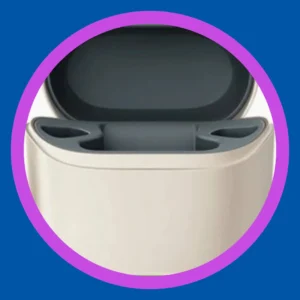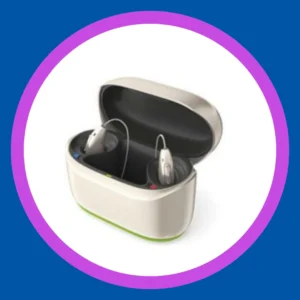Rechargeable Hearing Aids: Make Your Life Easier
Rechargeable hearing aids are changing the way people experience better hearing. Whether you’re new to hearing aids or have been using them for years, there’s a good chance you’ve heard about the benefits of rechargeable models. From easier daily routines to smart features and long-term savings, these modern devices offer incredible value and simplicity.
At Stanford Hearing, we understand that your hearing solution needs to match your lifestyle. That’s why we help you choose the best rechargeable hearing aids based on your goals, your hearing needs, and your comfort.
In this article, we’ll explore the advantages of rechargeable hearing aids, how they work, how they compare to traditional battery models, and what you should look for when making your decision.
Why More People Are Switching to Rechargeable Hearing Aids
In the United States, about 80% of all hearing aids sold today are rechargeable. That number is climbing fast. Why the shift?
Because people want fewer hassles. They want fewer small batteries, less maintenance, and more time doing the things they love.
Let’s take a closer look at what makes rechargeable hearing aids so popular:
Key Benefits:
- Convenience: No more fumbling with tiny batteries.
- Eco-friendly: Reduces waste and environmental impact.
- Cost-effective: Saves money over time by eliminating frequent battery purchases.
- Long battery life: Most models offer 24+ hours of power.
- Safer for kids and pets: No loose button batteries to worry about.
Some Limitations:
- Charging required: If you forget to charge, you’re stuck without power.
- Battery replacement requires a clinic visit: Not a DIY swap.
- Not ideal for everyone: If you’re frequently away from electricity, standard battery models might work better.
But here’s the big picture: According to a recent report, over 85% of users are satisfied with rechargeable hearing aids. That’s a strong vote of confidence in their ease and reliability.
A Day in the Life With Rechargeable Hearing Aids
Let’s walk through what life looks like with rechargeable hearing aids.
You wake up, take your hearing aids out of their case, and they’re fully charged. You go through your day—meetings, errands, a walk with your dog, streaming a podcast, chatting with family. Through it all, your hearing aids just work.
No dead batteries. And no late night runs to the pharmacy. No frustration.
And when it’s time for bed? You pop them back into the charger. That’s it. They’re ready again tomorrow.
For active users, travelers, and anyone who enjoys seamless technology, this simplicity is a game changer.

A Quick Look at the Technology Inside
Rechargeable hearing aids use lithium-ion or silver-zinc batteries. Most newer models use lithium-ion because they’re longer-lasting and more durable.
Lithium-ion batteries:
- Built directly into the hearing aid
- Last up to 5 years before needing replacement
- Power your devices for 24 to 36 hours on one charge
- Fully recharge in about 3 to 4 hours
- Allow quick charging (15 minutes = 3 hours of use)
For a deeper dive into lithium-ion research and usability, check out this helpful study on time savings and ease of use.

Pro Tips for Getting the Most From Your Rechargeable Hearing Aids
Even the best rechargeable hearing aids need a little care. Follow these tips to keep them working at their best:
- Use the correct charger: Only use the charger from the manufacturer.
- Charge overnight: Make it part of your bedtime routine.
- Don’t dock them in an unplugged charger: That drains the battery.
- Keep them dry: Avoid water and humidity.
- Store at a safe temperature: Keep them between 50°F and 90°F.
- Clean regularly: Wipe away wax and debris to prevent blockages.
With just a few good habits, your hearing aids will stay dependable, clean, and fully powered each day.
Meet the Rechargeable Hearing Aids at Stanford Hearing
At Stanford Hearing, we carry the top brands in rechargeable hearing technology. Let’s walk through what each one offers and who might benefit most from each model.
Phonak: Smart, Sleek, and Powerful
Phonak is one of the leaders in rechargeable hearing aids. Their latest models deliver advanced sound processing, Bluetooth connectivity, and long battery life.
⭐ Featured Models:
- Phonak Audéo Sphere Infinio: Uses the advanced DEEPSONIC AI chip for clearer speech in noise. Up to 16–36 hours of use.
- Phonak Audéo Lumity: Offers waterproof options and Bluetooth streaming. Designed for active, connected users.
Why users love them:
- Built-in motion sensors for adaptive hearing
- Rechargeable case with power bank option
- Health tracking through the myPhonak app
Phonak also ranks high for streaming clarity, especially if you take calls or listen to music through your hearing aids.
ReSound: Natural Sound, Cutting-Edge Connections
ReSound offers powerful rechargeable hearing aids with crisp sound and smart AI-driven processing.
⭐ Featured Models:
- ReSound Vivia: Their latest flagship with 30-hour battery life, intelligent focus, and Auracast streaming.
- ReSound Nexia: Discreet, stylish, and perfect for tech-savvy users.
Highlights:
- Bluetooth LE Audio for crystal-clear streaming
- Rechargeable MicroRIE style for comfort and power
- Compatible with the ReSound Smart 3D app for remote adjustments
ReSound models are ideal if you value natural sound and subtle design.
Starkey: AI-Powered and Health-Focused
Starkey is known for integrating AI and wellness tracking into their rechargeable hearing aids.
⭐ Featured Models:
- Starkey Edge AI: Offers up to 51 hours of battery life. Tracks movement, detects falls, and supports Bluetooth LE Audio.
- Starkey Genesis AI: Up to 42 hours of battery, custom fit options, and wellness features.
Why users love them:
- My Starkey app provides full control and health monitoring
- Ideal for users who want all-in-one tech and accessibility
Starkey also provides rechargeable custom in-the-ear models, which are great for those who want a tailored, discreet fit.
Unitron: Personalized Sound, Flexible Options
Unitron focuses on real-world listening, offering flexible technology you can try before buying.
⭐ Featured Models:
- Unitron Vivante: Designed for noisy environments and personalized performance.
- Unitron Moxi Blu: Known for comfort, connectivity, and hands-free calling.
Standout Features:
- FLEX:TRIAL system lets you test different tech levels
- Rechargeable RIC styles that are easy to wear and manage
- Smart adjustments based on your environment
Unitron is great if you want to try out options before making a commitment.
Understanding Charger Types and Battery Care
There are two main rechargeable battery types: lithium-ion and silver-zinc.
Lithium-ion (most common):
- No battery door
- Holds charge for 24+ hours
- Lasts 4–5 years before replacement
Silver-zinc:
- Has a battery door
- Lasts about a year
- Less common but still found in some models
Charging Tips:
- Always use a plugged-in charger
- Avoid leaving in heat or cold
- Wipe contacts clean regularly
- Remove from charger once fully charged
With the right care, your rechargeable battery will deliver years of reliable performance.
Daily Life Improvements You Can Expect
Still wondering how rechargeable hearing aids can improve your life? Here’s a breakdown of real-life benefits:
In the Morning:
You don’t need to check for spare batteries. Just grab your fully charged aids and go.
At Work:
No worries about your battery dying during a meeting. Enjoy seamless audio streaming on calls.
In Social Settings:
Stay engaged in conversation with advanced background noise filtering and speech clarity.
While Exercising:
Water-resistant models hold up during workouts. Some models adapt to your movement automatically.
When Traveling:
Pack your charger, and you’re good to go. Portable charging cases provide backup power on the move.
At Night:
Place your aids in the charging dock and sleep easy. No extra steps, no loose batteries.

Frequently Asked Questions About Rechargeable Hearing Aids
How long does a full charge last?
Most models last 24 to 36 hours on one charge, depending on usage.
How long does charging take?
A full charge takes about 3 hours. Quick charging gives 3 hours of use from 15 minutes.
Do I need to replace the battery?
Not often. Lithium-ion batteries last 4 to 5 years. After that, a hearing care provider can replace it.
What if I forget to charge them?
Many models come with portable charging cases. If you don’t have one, contact your provider for help.
Can I use any charger?
No. Always use the manufacturer’s approved charger to avoid damaging your hearing aids.
Are Rechargeable Hearing Aids Right for You?
Rechargeable hearing aids are a smart choice for many people, but they’re not for everyone.
You may benefit most if you:
- Prefer simplicity over changing batteries
- Have limited dexterity or vision
- Want a more environmentally friendly option
- Use your hearing aids for long hours each day
- Frequently stream audio or make calls
If you live off-grid or frequently go days without access to power, standard battery models might be better. But for most users, rechargeables offer flexibility, peace of mind, and a better experience overall.
Final Thoughts: Say Goodbye to Batteries
Today’s rechargeable hearing aids offer powerful performance, smart features, and unmatched convenience. They make daily life easier, cleaner, and less stressful. Whether you’re working, traveling, exercising, or relaxing at home, they help you hear better and worry less.
Interested in trying rechargeable hearing aids for yourself?
Contact Stanford Hearing to schedule a hearing consultation and explore the latest technology from Phonak, ReSound, Starkey, and Unitron. Let us help you find rechargeable hearing aids that fit your hearing goals and your lifestyle.
